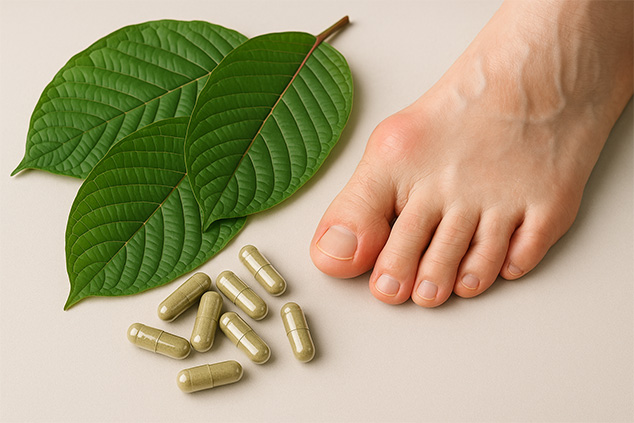There are several types of arthritis that affect the American population. Gout is one of them. So, if you have heard of the beneficial effects of kratom, you may be wondering if you can also take kratom for gout pain.
What Is Gout?
Gout is a common type of inflammatory arthritis. It results from the buildup of uric acid in the joints that causes sudden and intense joint pain.
Gout usually affects a single joint at a time, the big toe being one of the most commonly affected areas. But it can affect other joints such as the other toe joints, knees, ankles, fingers, and wrists.
Over the past few decades, the instances of gout in the United States have increased and more than doubled since the 1960s.
According to data, men have been historically more likely to be affected by it. Nonetheless, recent data shows that that may be evening out and more women are suffering from gout than before.
Symptoms of Gout
The onset of gout symptoms is usually sudden and severe and commonly happens at night. At times symptoms become worse. That is a period known as a flare-up. However, there will also be periods of remission when there are no symptoms at all.
The most common gout symptoms include:
- Severe joint pain for four to twelve hours, which usually becomes less intense later on but till persists
- Inflammation, redness, tenderness, and swelling in the joints
- Limited range of motion in the joints as gout progresses
- Discomfort for days or weeks after the pain has subsided
Common Causes of Gout
A condition called hyperuricemia causes gout. It occurs when there is excess uric acid in the body. Our bodies produce uric acid when breaking down purines, chemical compounds found naturally in the body as well as the foods that we consume.
Purines are commonly found in foods such as organ meat, red meat, seafood, alcohol, especially beer, sugary beverages, and foods. Normally, the body breaks down uric acid, passes it through kidneys, and excretes through urine.
However, it may happen that your body produces excess uric acid or your kidneys only excrete a small amount. This can lead to uric acid buildup in the body in joints or joint area. Uric acid then forms into urate crystals, which are sharp and needle-like and cause pain, swelling, and inflammation.
Various factors can increase the risk of developing gout. These are:
- Family history of gout. People with close relatives who suffer from gout are more likely to develop it too.
- Excess weight. Overweight bodies tend to produce more uric acid and kidneys have a harder time excreting it all.
- Consuming red meat, sugary beverages and foods, alcohol, especially beer, and other foods that are high in uric acid also increase the risk.
- Certain medical conditions. Heart and kidney diseases, diabetes, untreated high blood pressure, and other medical conditions can increase the risk of gout.
- Certain medications. Diuretics, low-dose aspirin, and anti-rejection medication for those who have had an organ transplant surgery can also increase the levels of uric acid.
Common Gout Treatment Methods
To manage gout, doctors advise a combination of medications and lifestyle changes. Common medications used are:
- NSAIDs (Nonsteroidal anti-inflammatory drugs) such as over-the-counter ibuprofen or naproxen sodium and prescription drugs indomethacin or celecoxib in more severe cases. These medications can have unpleasant side effects like stomach pain, ulcers, or bleeding.
- Doctors may also suggest it for gout pain management. However, this mediation has unpleasant side effects, especially if taken in large quantities. These include vomiting, diarrhea, and nausea.
- Doctors may recommend this drug to manage pain and inflammation if a gout patient cannot take NSAIDs and colchicine.
- Medications that block the production of uric acid. To prevent complications, doctors can recommend xanthine oxidase inhibitors (XOIs) which limit how much uric acid the body produces. Nonetheless, side effects include low blood count, rash, nausea, impaired liver function, higher heart-related death risk.
- Medications that improve the removal of uric acid. Taken together with XOIs, uricosurics, such as probenecid and lesinurad improve the ability of kidneys to eliminate uric acid from the body. Their side effects include stomach pain, rash, and kidney stones.
In addition to medication, medical professionals also recommend:
- Losing weight
- Exercising
- Reducing the amount of uric acid-rich foods in the diet
- Reducing the consumption of sugary beverages and foods
- Avoiding alcohol, especially beer
- Some evidence also shows that intake of Vitamin C and cherries, as well as moderate intake of coffee, could be helpful for gout pain and inflammation
Sadly, the medication commonly recommended and prescribed for gout has unpleasant and even dangerous side effects. In some cases, gout can be treatment-resistant, requiring the person to deal with excruciating pain with little or no support. Due to that, many see alternative treatment methods.

Can You Take Kratom for Gout Pain Relief?
While there is no easy fix, combined with weight and diet management, kratom can provide natural pain relief for gout and other benefits without dangerous side effects that over-the-counter or prescription gout medication can have.
Here are a few ways in which kratom for gout can be beneficial:
1. Effective Pain Relief
Kratom is best known for its powerful pain relief with minimal side effects. It can be effective for various chronic conditions such as arthritis, fibromyalgia, and even provide support with conditions such as cancer and pain that is resistant to pain medication. Kratom is also not as addictive as pain medications are.
2. Improved Sleep
Since gout tends to affect one during the night, kratom can provide both pain relief and the ability to fall and stay asleep.
3. More Energy
Pain and discomfort due to gout can reduce one’s ability to lead an active day-to-day life. Kratom can provide pain relief as well as increase physical energy and serve as a replacement for coffee.
4. Reduced Stress and Anxiety
Certain conditions such as diabetes can become easier to manage if one effectively manages stress and anxiety. Kratom can ease stress and anxiety, improving the symptoms of diabetes and other conditions, naturally supporting the body’s ability to naturally manage uric acid.
5. Weight Management Support
Kratom users tend to take better care of their health and diet. Moreover, they also report feeling less hungry during meals. While kratom will not make you lose weight, its regular use can support your body and mind on the weightloss journey.
Kratom has a wide range of alkaloids, many of which have anti-inflammatory and antioxidant properties. While more research is needed, these lesser-known alkaloids could possibly help the body manage inflammation.
Best Types of Kratom for Gout?
While individual needs may vary, red vein and green vein can be the most effective types of kratom for gout pain management. Red vein strains are best for the nighttime while during the day, green vein kratom can provide more effective support for gout.
Can Kratom Cause Gout?
On several occasions, kratom users have pointed out that they have experienced gout symptoms after kratom use. Yet, it most commonly stems from their diet and lack of hydration. Keep in mind that kratom can dehydrate you can cause constipation. So, if you do not support your body with proper diet and nutrition, such dehydration may lead to higher uric acid levels.
With proper nutrition and water intake, however, kratom can be extremely effective for gout pain relief.
Have you tried kratom for gout pain relief? How did it make you feel? What other lifestyle changes or supplements did you try? Were they effective or not?



Leave a Reply